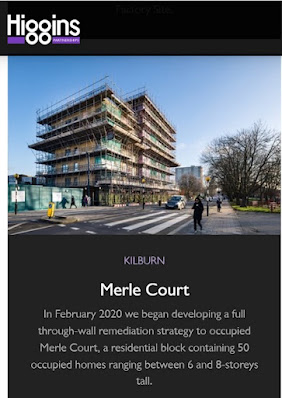The buildings known collectively as Granville New Homes sold by builders Higgins to Brent Council for £17.1m now look likely to cost Brent Council taxpayers £20m-£22m to bring up to standard. Market conditions, including the cost of materials means that officers warn the council that costs could rise further. If more people have to be decanted than allowed for whilst works go on, that will also add to costs.
The whole thing is a scandal and a nightmare for residentts and tenants in which Higgins seem to have got away scot free. They have even been given additional work by Brent Council:
The report going to Cabinet on November 14th clearly outlines the poor quality of the build:
4.0 Survey Findings
4.1 There are two main issues with the blocks. These are the water ingress at various locations in the blocks and uncertainty about the fire rating of the external and internal walls and floors. These two issues are interlinked as they are generally related to the same construction elements. Thus, both issues will be resolved in tandem.
Fire Safety
4.2 The fire risk assessment for the blocks, and the subsequent intrusive investigations have identified that the construction is poor. The blocks have two distinct methods of cladding. One is formed of cementitious panels and the other is of brick effect panels. Both of these appear to have a variety of insulation materials, including expanded polystyrene, mineral wool and void spaces. Because of this, the fire rating of the blocks is uncertain. However, they will certainly not comply with current building regulations and are unlikely to have complied with the class 0 requirements at the time of construction.
4.3 The panels and insulation will require to be removed and replaced with A1 or A2 rated materials to comply with building regulations.
Water Penetration
4.4 The properties have suffered from water penetration for many years. Attempts at remediation have been unsuccessful.
4.5 Ridge Consultants were commissioned to undertake an intrusive survey of the blocks and to identify any significant areas of defect.
4.6 Ridge’s findings are as follows:-
o The external envelopes on these buildings have been constructed from relatively inexpensive materials and there is evidence of poor-quality workmanship.
o There is a lack of information available, relating to the original build and it is clear that what has been installed on site has not worked.
o The doors and windows are suffering rot and timber decay, which is not, a defect readily associated with buildings of this age.
o The horizontal surfaces to the external envelopes (roofs, balconies and walkways) have been poorly finished.
o A further note is that none of the components that have been installed should have failed because of age.
4.7 Ridge’s recommendations are as follows:
o · The defects noted in relation to the buildings’ external envelopes are not easily repairable in a way that will offer a guaranteed and satisfactory solution. On this basis, the only available option is to replace the facades, roof coverings and balcony waterproofing systems.
o · All specified systems and products will have long insurance backed guarantees. All designers and the main contractor will provide warranties. The Council’s legal team will review these before making any appointments.
4.8 A key to being able to complete these works without decanting residents is being able to work without disturbing the internal blockwork leaf of the system. It is likely that once the cladding is removed, the blockwork wall behind it will remain intact. This may mean that not all residents require being decanted. Only vulnerable residents may require decanting.
Energy Efficiency
4.9 As a consequence of the fire safety works specification. The energy efficiency rating of the properties will also be improved.
5.0 Works undertaken to Date
5.1 It was identified that the blocks have suffered from a number of defects, which included fire safety issues, water penetration, window and cladding defects.
5.2 In addition to the above the Fire Brigade served FWH with Enforcement Notices, which led to a waking watch to be introduced in the blocks.
5.3 A comprehensive communal and dwelling interlinked fire alarm system has been installed into the properties. This has now been set up with alarm monitoring arrangements.
5.4 In addition, combustible materials have been removed from communal areas and additional fire stopping has being installed. The waking watch has been removed as the alarm monitoring has been commissioned and now in use.
5.5 The fire alarm system will be monitored in order that any suspected smoke or fire is alerted to the London Fire Brigade.
6.0 Budget Requirements
6.1 The nature of the works is significant and therefore costly. The estimated cost of the works and associated works and consultancy services is £19,870,804. This includes costs associated with supporting more vulnerable residents such as respite care and temporary decanting, inflation and a contingency. The works are high risk and the market is currently extremely volatile in terms of costs and pricing, hence the large contingency. In addition, it is prudent at this stage to make provision for the potential decant of a significant number of residents who may not be vulnerable but who may not be able to stay in their homes during some or all of the works. Therefore, Cabinet is requested to allocate £22M plus VAT to this project.
6.2 The difference in cost from the 6 December Cabinet report is due to ongoing uncertain market cost conditions, and the addition of VAT. Some allowance has been made for ongoing building cost inflation. However, due to several uncertainties in the marketplace and world events, there may be further building cost increases. Cabinet will be advised of this should this become apparent during the course of the project.
HISTORICAL INFORMATION
Brent Executive Plans including Wembley and South Kilburn when there was a Liberal Democrat-Conservative Coalition LINK
Impact Needs Assessment completed by Robert Johnson, then Housing and Community Care Project Manager, South Kilburn, now a Labour councillor. LINK
Reponse to a Freedom of Information Request re the South Kilburn Redevelopment LINK














